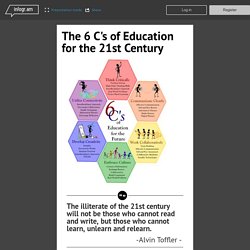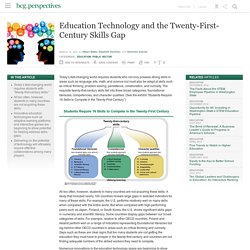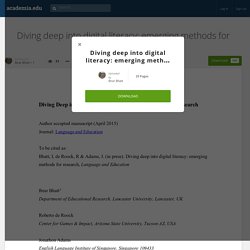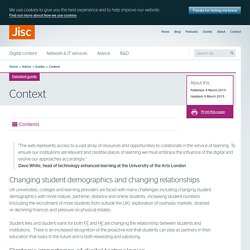

New Literacies Around the Globe: Policy and Pedagogy - Cathy Burnett, Julia Davies, Guy Merchant, Jennifer Rowsell. Cathy Burnett is Reader in the Department of Teacher Education at Sheffield Hallam University in the United Kingdom, where she leads the Language and Literacy Research Group.

She has published widely in the field of literacy in education and co-edits the United Kingdom Literacy Association journal, "Literacy. "Her research interests are concerned with relationships between literacies within and beyond educational contexts and with meaning-making in hybrid on/offline spaces. Data literacy and skills development vital to UK economic health. The 6 C`s of Education for the 21st Century - Infogram, charts & infographics. The illiterate of the 21st century will not be those who cannot read and write, but those who cannot learn, unlearn and relearn.

CRITICAL THINKING allows the individual to manage information. Information presented in a multitude of forms from a variety of media. Information that must be filtered and analyzed, authenticated and processed, and eventually must be synthesized in a form that will be useful to the individual. CRITICAL THINKING is PROBLEM SOLVING, the ability to take information and put it to use to create solutions. COMMUNICATION provides the means by which the individual can present information. COLLABORATION engages the individual in the world they share through association. CREATIVITY provides the avenue for expression. CULTURE encourages the individual to appreciate where we have come from, who we are now and how we can move into the future. CONNECTIVITY places the individual in touch with their world.
Education Technology and the Twenty-First-Century Skills Gap. Today’s fast-changing world requires students who not only possess strong skills in areas such as language arts, math, and science but must also be adept at skills such as critical thinking, problem solving, persistence, collaboration, and curiosity.

The requisite twenty-first-century skills fall into three broad categories: foundational literacies, competencies, and character qualities. (See the exhibit “Students Require 16 Skills to Compete in the Twenty-First Century.”) All too often, however, students in many countries are not acquiring these skills. A study that included nearly 100 countries reveals large gaps in selected indicators for many of these skills. For example, the U.S. performs relatively well on many skills when compared with the entire world. Numerous innovations in the education technology space are beginning to show potential for helping address skills gaps.
Diving deep into digital literacy: emerging methods for research. And interweave the contents of a previous assignment into the current file.

She does this whilst discussing henna styles with Lauren (the student beside her). The writing of the new assignment is already well under way. Sara t hen starts discussing the assignment’s contents further, repeating the same questions that she asked the teacher to Lauren beside her, as she glances at the whiteboard instructions, her already notes from the previous session, and her screen.
Just copy and paste... from a similar previous assignment, ‘...cos it’s our own words anyway . Pauses, and then refers to Google for information on ‘child protection’. S interruptions and suggestions leave her stumbled, so she asks Lauren and the teacher again for help. Figure 1. Where Does Our Digital Literacy Come From? We often talk about digital literacy, technology competency, and/or social media prowess.

In 2015, there is an assumption that those of us who work in higher education will have some degree of technology fluency that will be used to affect our professional existence in some way or another. Our ability to navigate the electronic waters of devices (both mobile and not-so-mobile), applications, and digital solutions is honed on a daily basis through formal learning experiences, autodidactic problem solving, social media engagement, errant mouse (or trackpad) clicks, Google searches, and CMD + Z. When we're hired, it's rare that our digital literacy will be assessed. And, perhaps even more telling, after we've been in our jobs for a bit, there's no rubric or measurement to see if we've grown more digitally literate.
Perhaps it's time to create assessments for higher education professionals that measure their digital literacy journey? What are you doing to become more digitally literate? An Error Occurred Setting Your User Cookie. Context. "The web represents access to a vast array of resources and opportunities to collaborate in the service of learning.

To ensure our institutions are relevant and credible places of learning we must embrace the influence of the digital and evolve our approaches accordingly. " Dave White, head of technology enhanced learning at the University of the Arts London Changing student demographics and changing relationships. Digital literacy: the perks and pitfalls of plugged-in students. Researchers using student data in learning analytics cannot ignore ethical concerns.

Plus the latest higher education appointments Source: Getty Crossed wires: analysis of students’ personal data raises privacy concerns The increasing number of digitally literate students, with constant access to the internet via their own handheld devices, can cause problems for lecturers – but they also offer scholars the opportunity to undertake new and exciting research methods.